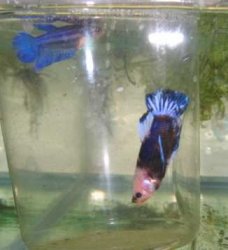Yep, TW, your link still comes up as an error for me, and Joep, your link comes up as the microsoft website.

Oh well. I'll look your fish up on Aquabid and see them there!

Joep, I'd like to read your article. I'm interested in what it says, and I hope it can clarify, because otherwise what you said doesn't ring right with me. What you are saying sure sounds a little Lamarkian - you know, the giraffe stretching his neck on purpose. If is was an gradual spread from veil to Delta to HM that happened over the course of 45 years, then that seems to be what you're implying. Now, we can "force" evolution through selective breeding, obviously, but I'm now wondering if any tail type should be considered genetic except short vs. long.
What I would REALLY like somebody to do is come up with some evidence - like a published research paper, or something like that. So far I have heard a lot that doesn't seem to fit together at all, and I have my own evidence that really makes me question some of the info passed around the two boards. I am thouroughly confused.
I emailed Jim Sonnier. Since it's looking at his spawns that has confused me so much, I figured I'd just go ahead and ask him.

Here's a copy of the email I sent him:
"Hi there Mr Sonnier -
I hope all is well with you. My name is Jennifer ********, and I have long been an admirer of your fish. In fact, I was sorely disappointed when I did not win a coveted melano plakat you had bred that was auctioned at the PNWBS in August. I have been enjoying following your work on the Giant gene as well - it's so interesting that it appears to be incompletely dominant.
I hope you can settle an issue that I am having. I had always believed, partially based on reviewing the results of your spawns, that when you cross a plakat with a superdelta or a Half Moon, you would have 100% longfin fish in the F1, and none should theoretically be veiltails, they should all be delta, SD (or HM, but not likely in the F1). Am I way off base with this thought? I have recently been told that I am incorrect, and that this spawn will result in veils. After directing the person to look at the results of some of your spawns, they said, well, a show plakat might throw deltas when crossed with a SD/HM, but a traditional plakat will
throw veils when crossed in the same manner. This doesn't make any sense to me - I understand that we've worked heavily with the show fish, but I can't understand why being a traditional plakat (particularly a traditional round tail plakat, not the spade tail) would make a difference genetically.
Here is a link to a forum I visit often where we are discussing this issue, if you would like to read more about our confusion *grin* :
http /www.fishforums.net/index.php?showtopic=73806
/www.fishforums.net/index.php?showtopic=73806
If you don't have time to answer this, I understand. I know you're a busy man.
Thanks in advance for your time"
 I was thinking this chick had a real awkward experience crossing plakat and HM or something
I was thinking this chick had a real awkward experience crossing plakat and HM or something 

 I was thinking this chick had a real awkward experience crossing plakat and HM or something
I was thinking this chick had a real awkward experience crossing plakat and HM or something 



 But all we've been talking about is what plakat does to half moon. What does HM do to a plakat line (not F1, obviously none would be plakats then
But all we've been talking about is what plakat does to half moon. What does HM do to a plakat line (not F1, obviously none would be plakats then  None go out from the base as if arraying around like a moon or sun. A delta tail would just need to exhibit 2 branches minimum, and rays that form a diamond or array coming from the base out. Now, if I'm wrong on this, someone correct me.
None go out from the base as if arraying around like a moon or sun. A delta tail would just need to exhibit 2 branches minimum, and rays that form a diamond or array coming from the base out. Now, if I'm wrong on this, someone correct me. /www.aquabid.com/cgi-bin/auction/auc...tasd&1106963301
/www.aquabid.com/cgi-bin/auction/auc...tasd&1106963301
 ) The link works for me, so I don't know. She is listed on Aquabid still at the moment under Incredible Black marble female from Bettas Galore.
) The link works for me, so I don't know. She is listed on Aquabid still at the moment under Incredible Black marble female from Bettas Galore.